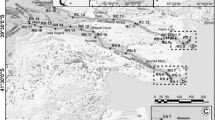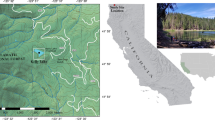Abstract
Surface sediments, water samples and environmental data from 37 lakes, ponds and streams in Israel were analysed to determine the main variables controlling ostracod species distributions. Multivariate statistical analysis revealed that the greatest amounts of variation in the distribution of the ostracod taxa among the 37 water bodies were explained by the host water δD value (12.9%), water temperature (11.0%), mean January air temperature (10.5%), electrical conductivity (9.5%), and the Mg and NO3 concentrations (7.8 and 7.1%, ion concentrations as % of the anions or cations). A supplementary data set comprising ostracod species composition and electrical conductivity readings for 24 water bodies was available from previous research and was merged with the 37 samples data set to develop an ostracod-based transfer function for the reconstruction of electrical conductivities. A weighted averaging partial least squares regression (WA-PLS) provided the best results with a relatively high coefficient of determination (r 2) between measured and inferred electrical conductivity values of 0.73, a root mean square error of prediction of 0.13 (13.4% of gradient length) and a maximum bias of 0.24 (23.9% of gradient length), as assessed by leave-one-out cross-validation based on 56 water bodies. The application of the EC transfer function onto (sub)fossil ostracod assemblages from Holocene and early to mid Pleistocene lake sediments provided EC values consistent with other proxies and demonstrated that Quaternary ostracod assemblages from subaqueous sediments can now be used to trace the hydrological history of water bodies in the Near East. A better understanding of past hydrological conditions in response to the natural climate variability is crucial in regions that face restricted water resources and rising demands in times of rapid climate and environmental change.










Similar content being viewed by others
References
Altinsaçli S, Kiliç M, Altinsaçli S (2000) A preliminary study on the Ostracoda (Crustacea) fauna of Lake Aksehir. Turk J Zool 24:9–16
Bar-Matthews M, Ayalon A, Gilmour M, Matthews A, Hawkesworth CJ (2003) Sea–land oxygen isotopic relationships from planktonic foraminifera and speleothems in the Eastern Mediterranean region and their implication for paleorainfall during interglacial intervals. Geochim Cosmochim Acta 67:3181–3199
Birks HJB (1998) Numerical tools in quantitative palaeolimnology–progress, potentialities, and problems. J Paleolimnol 20:307–332
Bitan A, Rubin S (1994) Climatic atlas of Israel for physical and environmental planning and design. Ramot Publishing, Tel Aviv University, Tel Aviv, p 244
Blaustein L, Margalit J (1991) Indirect effects of the fairy shrimp, Branchipus schaefferi and two ostracod species on Bacillus thuringiensis var israelensis-induced mortality in mosquito larvae. Hydrobiologia 212:67–76
Bodergat A-M (1983) Les Ostracodes, témoins de leur environnement: approche chimique et écologique en milieu lagunaire et océanique. Documents des Laboratoires de Géologie de la Faculté des Sciences de Lyon 88, p 246
Danielopol DL (1973) Sur la morphologie des aesthetascs chez quelques Ostracodes hypogés de la sous-famille des Candoninae (Cyprididae, Podocopida). Ann Spéléol 28:233–245
Eugster HP, Jones BF (1979) Behavior of major solutes during closed-basin brine evolution. Am J Sci 279:609–631
Frenzel P (1991) Die Ostracodenfauna der tieferen Teile der Ostsee-Boddengewässer Vorpommerns. Meyniana 43:151–175 (in German with English abstract)
Frenzel P, Boomer I (2005) The use of ostracods from marginal marine, brackish waters as bioindicators of modern and Quaternary environmental change. Palaeogeogr Palaeoclimatol Palaeoecol 225:68–92
Frogley MR, Griffiths HI, Heaton THE (2001) Historical biogeography and late Quaternary environmental change of Lake Pamvotis, Ioannia (north-western Greece): evidence from ostracods. J Biogeogr 28:745–756
Gasse F, Juggins S, Ben Khelifa L (1995) Diatom-based transfer functions for inferring past hydrochemical characteristics of African lakes. Palaeogeogr Palaeoclimatol Palaeoecol 117:31–54
Graf H (1938) Beitrag zur Kenntnis der Muschelkrebse des Ostalpengebietes. Arch Hydrobiol 33:401–501 (in German)
Griffiths HI, Schwalb A, Stevens LR (2001) Environmental change in southwestern Iran: the Holocene ostracod fauna of Lake Mirabad. The Holocene 11:757–764
Hartmann G (1964) Das Problem der Buckelbildung auf Schalen von Ostracoden in ökologischer und historischer Sicht. Mitt Hamburg Zool Mus Inst 61:59–66 (in German with English abstract)
Hiller D (1972) Untersuchungen zur Biologie und zur Ökologie limnischer Ostracoden aus der Umgebung von Hamburg. Arch Hydrobiol 40:400–497 (in German with English abstract)
Hölting B (1992) Hydrogeologie. Einführung in die allgemeine und angewandte Hydrogeologie. Enke, Stuttgart, p 425 (in German)
Janz H (1994) Zur Bedeutung des Schalenmerkmals ‘Marginalrippen’ der Gattung Ilyocypris (Ostracoda, Crustacea). Stuttgarter Beiträge zur Naturkunde Serie B 206:1–19 (in German with English abstract)
Juggins S (2003) User guide C2, software for ecological and palaeoecological data analysis and visualisation, user guide version 1.3. Department of Geography, Newcastle
Kempf EK (1973) Ostrakoden aus dem Jungpleistozän des Damaskus-Beckens. Z Geomorph 17:336–347 (in German)
Keyser D (2001) Cytological aspects in the noding process of Cyprideis torosa. 14th International Symposium on Ostracoda, Programs and Abstracts, The Organising Committee of ISO 2001, Shizuoka, p 38
Külköylüoğlu O (2003) Ecology of freshwater Ostracoda (Crustacea) from lakes and reservoirs in Bolu, Turkey. J Freshw Ecol 18:343–347
Lerner-Seggev R (1968) The fauna of Ostracoda in Lake Tiberias. Isr J Zool 17:117–143
Marchetto A, Colombaroli D, Tinner W (2008) Diatom response to mid-Holocene climate change in Lago di Massaciuccoli (Tuscany, Italy). J Paleolimnol 40:235–245
Martens K (1993a) The ostracod fauna of the old Lake Hula (Israel) (Crustacea, Ostracoda). Trav Sci Mus Natl Hist Nat Luxemb 19:67–75
Martens K (1993b) On the taxonomy and zoogeography of the genus Gomphocythere Sars, 1924 (Crustacea, Ostracoda), with the description of a new species from the Nahal Dan (Israel). Belg J Zool 123:39–54
Martens K (1996) On Heterocypris reptans (Kaufmann, 1900) (Ostracoda) Cyprididae, a new record of Israel. Isr J Zool 42:287–291
Martens K (1997) Two new crenobiont ostracod genera (Crustacea, Ostracoda, Herpetocypridinae) from Africa and Asia Minor, with the description of a new species from dolomitic springs in South Africa. S Afr J Sci 93:542–554
Martens K, Ortal R (1999) Diversity and zoogeography of inland-water Ostracoda (Crustacea) in Israel (Levant). Isr J Zool 45:159–173
Martens K, Ortal R, Meisch C (1992) The ostracod fauna of Mamilla Pool (Jerusalem, Israel) (Crustacea, Ostracoda). Zool Middle East 7:95–114
Martens K, Schwartz SS, Meisch C, Blaustein L (2002) Non-marine Ostracoda (Crustacea) of Mount Carmel (Israel), with taxonomic notes on Eucypridinae and circum-mediterranean Heterocypris. Isr J Zool 48:53–70
Meisch C (2000) Freshwater Ostracoda of Western and Central Europe. Spektrum, Heidelberg, p 522
Mezquita F, Roca JR, Reed JM, Wansard G (2005) Quantifying species–environment relationships in non-marine Ostracoda for ecological and palaeoecological studies: examples using Iberian data. Palaeogeogr Palaeoclimatol Palaeoecol 225:93–117
Mischke S (2001) Mid and late Holocene palaeoenvironment of the lakes Eastern Juyanze and Sogo Nur in NW China, based on ostracod species assemblages and shell chemistry. Berliner Geowissenschaftliche Abhandlungen Reihe E 35:1–131
Mischke S, Wünnemann B (2006) The Holocene salinity history of Bosten Lake (Xinjiang, China) inferred from ostracod species assemblages and shell chemistry: possible palaeoclimatic implications. Quat Int 154–155:100–112
Mischke S, Herzschuh U, Sun Z, Qiao Z, Sun N, Zander AM (2006) Middle Pleistocene Ostracoda from a large freshwater lake in the presently dry Qaidam Basin (NW China). J Micropalaeontol 25:57–64
Mischke S, Herzschuh U, Massmann G, Zhang C (2007) An ostracod-conductivity transfer function for Tibetan lakes. J Paleolimnol 38:509–524
Mischke S, Sun Z, Herzschuh U, Qiao Z, Sun N (2009) An ostracod-inferred large middle Pleistocene freshwater lake in the presently hyper-arid Qaidam Basin (NW China). Quat Int. doi:10.1016/j.quaint.2009.03.002
Morrison J, Brockwell T, Merren T, Fourel F, Phillips AM (2001) On-line high-precision stable hydrogen isotopic analyses on nanoliter water samples. Anal Chem 73:3570–3575
Neumann F, Schölzel C, Litt T, Hense A, Stein M (2007) Holocene vegetation and climate history of the northern Golan heights (Near East). Veg Hist and Archaeobot 16:329–346
Olander H, Birks HJB, Korhola A, Blom T (1999) An expanded calibration model for inferring lakewater and air temperatures from fossil midge assemblages in northern Fennoscandia. The Holocene 9:279–294
Picard IL (1959) Geological Map Israel. 1:500,000. Survey of Israel
Por FD (1968) The invertebrate zoobenthos of Lake Tiberias: I qualitative aspects. Isr J Zool 17:51–79
Reed JM (1998a) A diatom-conductivity transfer function for Spanish salt lakes. J Paleolimnol 19:399–416
Reed JM (1998b) Diatom preservation in the recent sediment record of Spanish saline lakes: implications for palaeoclimate study. J Paleolimnol 19:129–137
Rosenfeld A, Vesper B (1977) The variability of the sieve-pores in recent and fossil species of Cyprideis torosa (Jones, 1850) as an indicator for salinity and palaeosalinity. In: Löffler H, Danielopol D (eds) Aspects of ecology and zoogeography of recent and fossil ostracods. Junk, The Hague, pp 55–67
Rosenfeld A, Nathan Y, Feibel CS, Schildman B, Halicz L, Goren-Inbar N, Siman-Tov R (2004) Palaeoenvironment of the Acheulian Gesher Benot Ya’aqov Pleistocene lacustrine strata, Northern Israel—lithology, ostracod assemblages and ostracod shell geochemistry. J Afr Earth Sci 38:169–181
Schwab MJ, Neumann F, Litt T, Negendank JFW, Stein M (2004) Holocene palaeoecology of the Golan Heights (Near East): investigation of lacustrine sediments from Birkat Ram crater lake. Quat Sci Rev 23:1723–1731
Starinsky A (1974) Relationship between Ca-Chloride brines and sedimentary rocks in Israel. Unpubl. PhD thesis, The Hebrew University of Jerusalem, Jerusalem, Israel, 176 pp (in Hebrew with English abstract)
ter Braak CJF, Šmilauer P (1998) CANOCO reference manual and user’s guide to Canoco for windows: software for canonical community ordination. Microcomputer Power, Ithaca
Välikangas I (1993) Über die Biologie der Ostsee als Brackwassergebiet. Verh Int Ver theor angew Limnol 6:62–112 (in German)
Van Harten D (1979) Some new shell characters to diagnose the species of the Ilyocypris gibba-biplicata-bradyi group and their ecological significance. In: Krstic N (ed) Taxonomy, biostratigraphy and distribution of ostracodes. Proceedings of the 7th International Symposium on Ostracodes, Belgrade, pp 71–76
Van Harten D (1996) Cyprideis torosa (Ostracoda) revisited. Of salinity, nodes and shell size. In: Keen MC (ed) Proceedings 2nd European Ostracodologists’ Meeting, British Micropalaeontological Society, London, pp 191–194
Vesper B (1972) Zum Problem der Buckelbildung bei Cyprideis torosa (Jones, 1850) (Crustacea, Ostracoda, Cytheridae). Mitt Hamburg Zool Mus Inst 68:79–94
Yang F, Sun Z, Zhang Y, Qiao Z (2002) Taxonomic significance of nodal ornamentation of Quaternary genus Ilyocypris (Ostracoda) from Qaidam Basin, Qinghai Province. Acta Micropalaeontol Sin 19:15–32
Acknowledgments
We are indebted to Dr. Hedi Oberhänsli (GFZ—German Research Centre for Geosciences) for her generous support of the project. We greatly acknowledge logistical help provided by Dr. Avraham Honigstein and assistance during fieldwork by Michael Kitin (both from Geological Survey of Israel). Jan Evers made SEM images of Ilyocypris specimens. Two thorough and detailed reviews were provided by Peter Frenzel and an anonymous reviewer. Funding was provided through the German–Israeli Foundation for Scientific Research and Development (GIF).
Author information
Authors and Affiliations
Corresponding author
Electronic supplementary material
Below is the link to the electronic supplementary material.
Rights and permissions
About this article
Cite this article
Mischke, S., Almogi-Labin, A., Ortal, R. et al. Quantitative reconstruction of lake conductivity in the Quaternary of the Near East (Israel) using ostracods. J Paleolimnol 43, 667–688 (2010). https://doi.org/10.1007/s10933-009-9359-y
Received:
Accepted:
Published:
Issue Date:
DOI: https://doi.org/10.1007/s10933-009-9359-y




